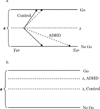Using the Diffusion Model to Explain Cognitive Deficits in Attention Deficit Hyperactivity Disorder
- PMID: 27030470
- PMCID: PMC5045756
- DOI: 10.1007/s10802-016-0151-y
Using the Diffusion Model to Explain Cognitive Deficits in Attention Deficit Hyperactivity Disorder
Abstract
Slow, variable, and error-prone performance on speeded reaction time (RT) tasks has been well documented in childhood ADHD, but equally well documented is the context-dependent nature of those deficits, particularly with respect to event rate. As event rates increase (or, as the interstimulus intervals become shorter), RTs decrease, a pattern of performance that has long been interpreted as evidence that cognitive deficits in ADHD are a downstream consequence of a fundamental difficulty in the regulation of arousal to meet task demands. We test the extent to which this is a misinterpretation of the data that occurs when RT and accuracy are considered separately, as is common in neurocognitive research. In two samples of children aged 8-10 with (N = 97; 33 girls) and without (N = 39; 26 girls) ADHD, we used the diffusion model, an influential computational model of RT, to examine the effect of event rate on inhibitory control in a go-no-go task. Contrary to longstanding belief, we found that fast event rates slowed the rate at which children with ADHD accumulated evidence to make a decision to "no-go", as indexed by drift rate. This in turn resulted in a higher proportion of failed inhibits, and occurred despite increased task engagement, as reflected by changes in the starting point of the decision process. Thus, although faster event rates increased task engagement among children with ADHD, the increased engagement was unable to counteract the concurrent slowing of processing speed to "no-go" decisions. Implications for theoretical models of ADHD and treatments are discussed.
Keywords: ADHD; Arousal; Diffusion model; Drift rate; Event rate; Inhibition.
Conflict of interest statement
The authors declare that there are no conflicts of interest.
Figures



Similar articles
-
Overlapping and Distinct Cognitive Impairments in Attention-Deficit/Hyperactivity and Autism Spectrum Disorder without Intellectual Disability.J Abnorm Child Psychol. 2018 Nov;46(8):1705-1716. doi: 10.1007/s10802-017-0394-2. J Abnorm Child Psychol. 2018. PMID: 29450820 Free PMC article.
-
Functional Neuroimaging Evidence for Distinct Neurobiological Pathways in Attention-Deficit/Hyperactivity Disorder.Biol Psychiatry Cogn Neurosci Neuroimaging. 2018 Aug;3(8):675-685. doi: 10.1016/j.bpsc.2017.09.005. Epub 2017 Sep 23. Biol Psychiatry Cogn Neurosci Neuroimaging. 2018. PMID: 30092917 Free PMC article.
-
A diffusion model analysis of sustained attention in children with attention deficit hyperactivity disorder.Neuropsychology. 2020 Sep;34(6):641-653. doi: 10.1037/neu0000636. Epub 2020 Apr 23. Neuropsychology. 2020. PMID: 32324003 Free PMC article.
-
A meta-analytic study of event rate effects on Go/No-Go performance in attention-deficit/hyperactivity disorder.Biol Psychiatry. 2012 Dec 15;72(12):990-6. doi: 10.1016/j.biopsych.2012.08.023. Epub 2012 Oct 11. Biol Psychiatry. 2012. PMID: 23062355 Review.
-
Modelling ADHD: A review of ADHD theories through their predictions for computational models of decision-making and reinforcement learning.Neurosci Biobehav Rev. 2016 Dec;71:633-656. doi: 10.1016/j.neubiorev.2016.09.002. Epub 2016 Sep 5. Neurosci Biobehav Rev. 2016. PMID: 27608958 Review.
Cited by
-
Acute Stimulant Treatment and Reinforcement Increase the Speed of Information Accumulation in Children with ADHD.J Abnorm Child Psychol. 2017 Jul;45(5):911-920. doi: 10.1007/s10802-016-0222-0. J Abnorm Child Psychol. 2017. PMID: 27787672 Free PMC article. Clinical Trial.
-
Task-general efficiency of evidence accumulation as a computationally-defined neurocognitive trait: Implications for clinical neuroscience.Biol Psychiatry Glob Open Sci. 2021 Jun;1(1):5-15. doi: 10.1016/j.bpsgos.2021.02.001. Epub 2021 Mar 13. Biol Psychiatry Glob Open Sci. 2021. PMID: 35317408 Free PMC article.
-
What cognitive processes are "sluggish" in sluggish cognitive tempo?J Consult Clin Psychol. 2019 Nov;87(11):1030-1042. doi: 10.1037/ccp0000446. J Consult Clin Psychol. 2019. PMID: 31613137 Free PMC article.
-
Assessing the Longitudinal Associations Between Decision-Making Processes and Attention Problems in Early Adolescence.Res Child Adolesc Psychopathol. 2024 May;52(5):803-817. doi: 10.1007/s10802-023-01148-8. Epub 2023 Dec 16. Res Child Adolesc Psychopathol. 2024. PMID: 38103132 Free PMC article.
-
Inhibitory Control and Information Processing in ADHD: Comparing the Dual Task and Performance Adjustment Hypotheses.J Abnorm Child Psychol. 2019 Jun;47(6):961-974. doi: 10.1007/s10802-018-0504-9. J Abnorm Child Psychol. 2019. PMID: 30547312 Free PMC article.
References
-
- Alderson RM, Rapport MD, Kofler MJ. Attention-Deficit/Hyperactivity disorder and behavioral inhibition: A meta-analytic review of the stop-signal paradigm. Journal of Abnormal Child Psychology. 2007;35:745–758. - PubMed
-
- Barkley RA. Behavioral inhibition, sustained attention, and executive functions: Constructing a unifying theory of ADHD. Psychological Bulletin. 1997;121:65–94. - PubMed
-
- Block RA, Hancock PA, Zakay D. How cognitive load affects duration judgments: A meta-analytic review. Acta Psychologica. 2010;134:330–343. doi: http://dx.doi.org/10.1016/j.actpsy.2010.03.006. - DOI - PubMed
MeSH terms
Grants and funding
LinkOut - more resources
Full Text Sources
Other Literature Sources
Medical
Research Materials

